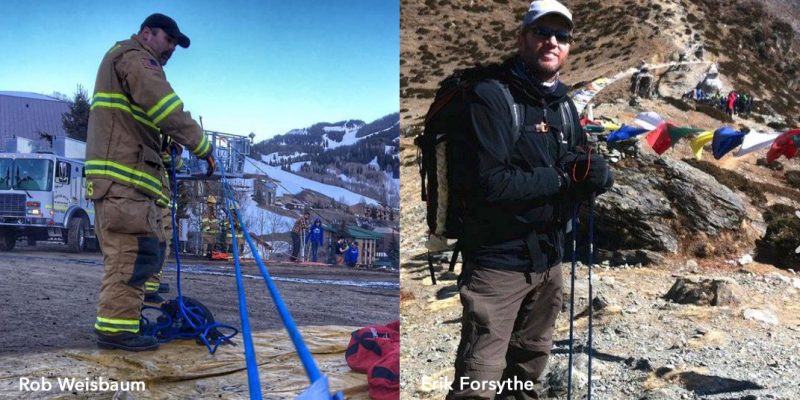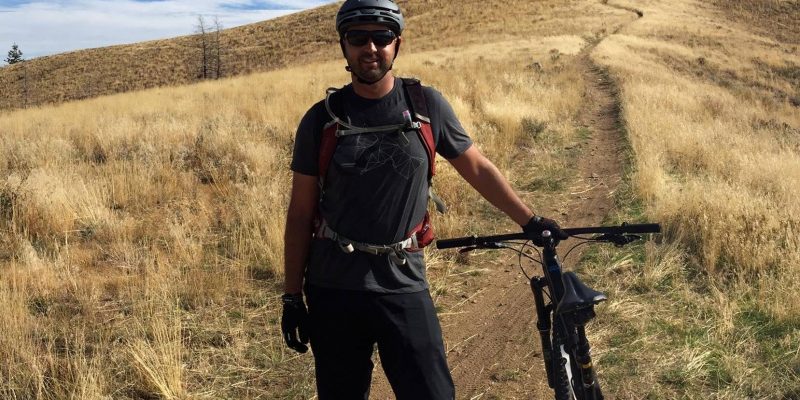Rob Weisbaum has never forgotten how lucky he is to be alive, and that thought galvanizes his sense of duty. In his early twenties, he was making his second skydiving jump out of a plane near his hometown of Detroit, Michigan. During the jump he miscalculated a turn, starting it too low, and slammed into the ground at sixty miles per hour, shattering both legs. His feet were literally turned backwards by the impact, splintered bones protruding through his skin.
His dad, Jerry, was initially unfazed when he received news of Rob’s accident. Rob had been an adrenalin junkie all his life, played hockey, and was an extreme skier. His dad had seen nearly every kind of injury that could happen to his son. It wasn’t until the trauma doctor at the University of Michigan hospital said bluntly, “Jerry, it’s really bad,” that he realized this one was serious. Rob was fortunate to be alive.
When the same doctor explained to Rob he would never walk again the news changed the course of Rob’s life. The experience of his first ever ride on a CareFlight–this one as a patient–had captivated him. He was so enthralled by the way the flight medics had worked with him, the ominous prognosis only flamed his motivation to prove the doctor wrong. More than anything, Rob knew he wanted to become a CareFlight medic.
The idea of being involved in emergency rescue services was not new to Rob. As a young boy growing up in suburban Detroit, he wanted to be a firefighter, similar to many other boys his age. But unlike most of the other boys, the idea did not fade as he grew older. When he was eighteen, he bravely strolled into a fire station situated just down the street from his house to ask them what he needed to do to become a fireman. “Get an Emergency Medical Technician’s license first,” they said–which he did. By the time he earned his license he had completely fallen in love with the field, and he continued his training to become a full paramedic. Ultimately, though, he thought, “I want to be a leader somehow–not a follower.”
After the sky diving accident, Rob endured a frustrating year of surgeries and grueling physical therapy. Remaining determined throughout, not only did he learn to walk again, he also met his goal to become a licensed flight medic. He was working for a flight rescue operation in Arizona when he saw a posting for a new job with CareFlight. He applied and was hired in 2009 to become the leader, not the follower, of a brand new CareFlight operation in Montrose, Colorado. Only a week after starting the job, he already had secured a helicopter, hired a nurse and a pilot, and was looking for additional support personnel.
Almost three years later, Rob’s good friend Erik Forsythe was newly appointed as Emergency Medical Services Chief at Gunnison Hospital, a role he had taken after retiring from a 19-year career as a ski patroller in Crested Butte. Coincidentally, like Rob, Erik was also from Michigan, but the two had never met before working together in Colorado.
Erik Forsythe and the Colorado mountains had met each other, though, when he was twelve years old, on a family vacation. And, it was love at first sight. Back in Ann Arbor, Michigan, his heart was never again far from the wilderness and the mountains. Describing himself as a late bloomer in sports, he says he “took an unsuccessful shot at playing football” in the ninth grade, finally turning to track and specializing in the pole vault through high school. While he was good at pole vaulting, he still remained heavily involved in the Boy Scouts and spent most weekends camping or skiing.
Erik could easily have followed his father, who was a successful second-generation attorney, into the family business. Instead, as soon as high school was finished, Erik followed his heart to the Colorado mountains without any clear notion of what he wanted to do once he got there. He eventually landed at Colorado University in Boulder where he says he “hacked” his education, spending two painful years as an economics major. He dropped out of CU to concentrate on becoming a ski patroller.
Then a new degree program at CU in environmental conservation caught his eye. The structure of the program would afford him the flexibility to go to school in the summer and take the winters off to follow his passion for skiing. He returned to CU to complete his degree while still working toward his license as an Emergency Medical Technician, a requirement for ski patrollers. After college, armed with a degree in environmental conservation and his EMT license, he began to expand his expertise in wilderness rescue.
Today, Erik is recognized worldwide for his expertise in wilderness rescue as a member the Wilderness Medical Collateral Associates, an international group dedicated to specialized wilderness medical training. He continues to travel across the US and around the world teaching the specialized techniques involved in wilderness rescue.
A particular piece of that teaching curriculum guided him on the afternoon of September 17, 2017 when he fielded a 9-1-1 call about an injured mountain biker on Doctor Park Trail. “Most EMT training is designed around metropolitan ambulance services, where you are always a relatively short distance from a hospital,” he explained. “No matter how bad it is, you get them into an ambulance and take them to the nearest hospital. But in wilderness rescue you have to make some big decisions based on the complexity of the situation which can make life and death differences.”
His immediate decision to bring Rob Weisbaum into the rescue operation may have made that kind of difference. Having made the call to Rob, Erik raced to spearhead the mission and join the rescue party on Doctor Park Trail. After reaching Theo and triaging his injury, he began exchanging text messages with Rob, who was already in range in the helicopter but was desperately trying to identify a suitable landing spot.
It became clear that Erik, at the bottom of a ravine in the forest, was in no position to direct the pilot to an appropriate landing site, which would have been their normal protocol. Erik and Rob agreed, finally, that the pilot would break convention and find his own landing space. The rescue team, then, carried Theo down the trail to start, then followed the sound of the rotors up the side of the ravine to the landing site to deliver him into Rob’s care.
When Erik looks back on Theo’s rescue, what makes him most proud is the way the multiple agencies worked as a team. “We just worked together, and we problem solved,” Erik told me. “By doing that, I think we saved Theo four or five hours in the time it took to get him to a surgeon.”
As the helicopter lifted off and headed towards Grand Junction, Rob looked down at Theo lying on the deck beneath him, and his memory flashed briefly back to that very first CareFlight. He understood exactly how Theo felt. Rob encouraged him to hope for the best, telling him that often things turn out to be completely different than what was presenting, and proclaimed, “Theo, let’s just do it.” Rob knew what he was talking about.
To learn more about Theo’s extraordinary rescue and recovery, buy the book, FINDING THEO: A Father’s True Story of Loss, Courage, and Discovery


